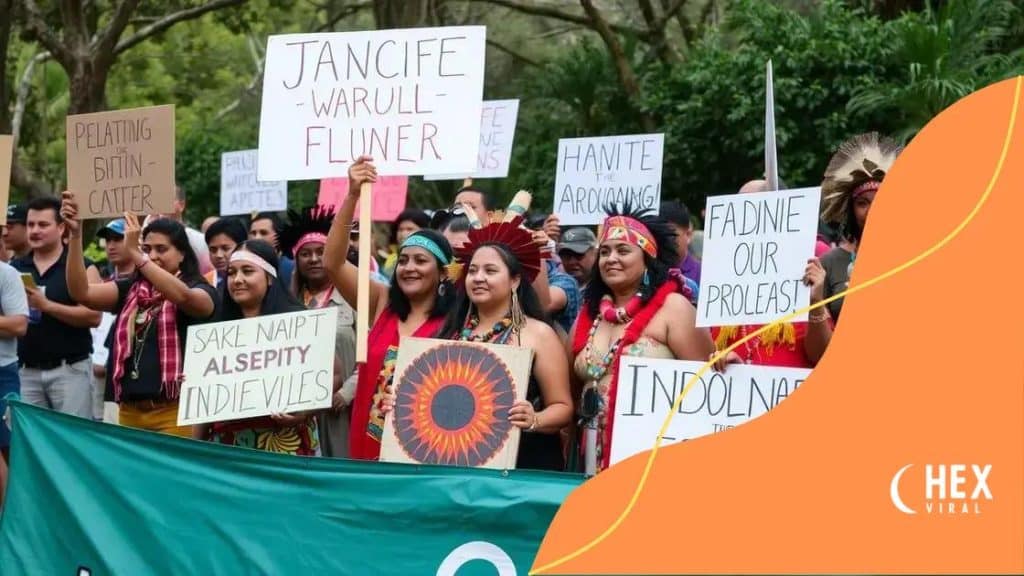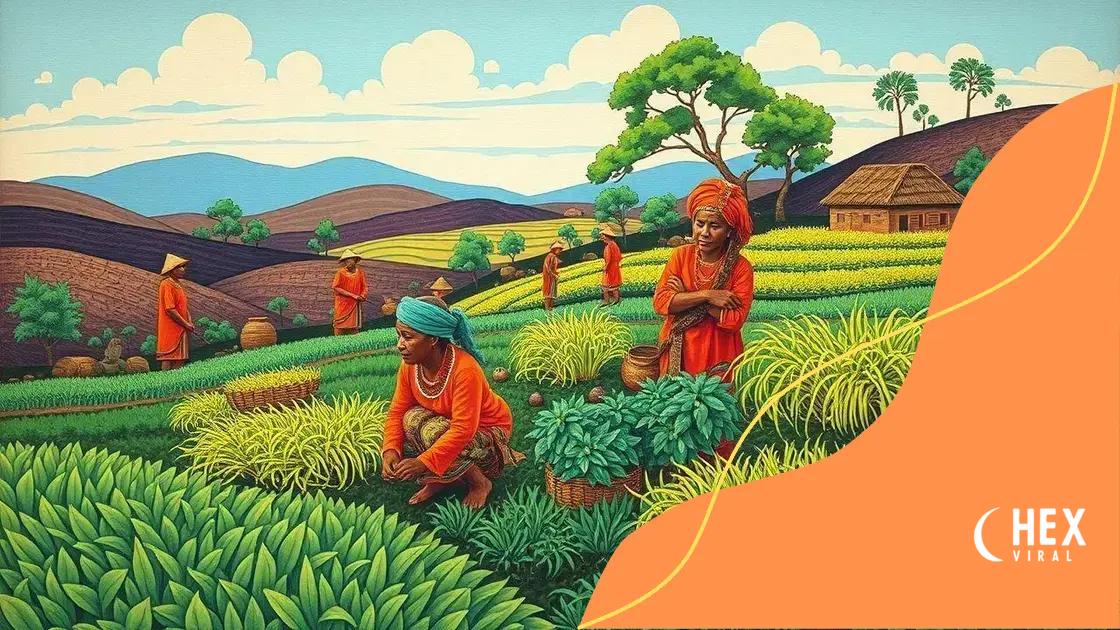Protest efforts for indigenous land rights are gaining momentum

Protest efforts for indigenous land rights focus on securing legal recognition, preserving cultural heritage, and leveraging technology while building collaborations to promote environmental sustainability and empower communities.
Protest efforts for indigenous land rights are becoming increasingly important as communities seek recognition and justice. Have you ever wondered how these movements shape society’s understanding of equity and respect for native cultures? Here, we’ll delve into their significance.
Historical context of indigenous land rights
The historical context of indigenous land rights is essential to understanding the current struggles faced by these communities. It is a story marked by the fight for recognition, respect, and justice. Many indigenous groups have had to endure centuries of dispossession, discrimination, and marginalization. This article will delve into key events and movements that have shaped their quest for rightful land ownership.
Colonial Impact on Indigenous Lands
When colonial powers arrived, they often ignored the existing land ownership of indigenous peoples. This led to significant loss of territory and resources. Understanding this history helps us appreciate the depth of the ongoing struggles.
- Loss of traditional lands through treaties
- Forced relocation and assimilation
- Destruction of cultural heritage
These events created lasting effects on indigenous communities, impacting their social, economic, and cultural livelihoods. As they lost their lands, they also lost their autonomy and identity.
Key Legislation and Movements
Throughout the years, various legal frameworks have emerged to address these historical injustices. Legislation aimed at rectifying past wrongs has been critical in the indigenous fight for land rights.
- The Indian Self-Determination Act of 1975
- The Native American Graves Protection and Repatriation Act
- The United Nations Declaration on the Rights of Indigenous Peoples
These laws represent milestones in acknowledging indigenous rights. They empower communities and provide a framework to reclaim their heritage.
As we analyze the evolution of indigenous land rights, it becomes crucial to recognize the persistence and resilience of these communities. Despite facing systemic challenges, indigenous groups continue to advocate for their rights.
The ongoing dialogue surrounding land rights reflects not just a struggle for land, but for identity, culture, and sovereignty. By understanding this history, we become better equipped to support indigenous rights today. The journey is still ongoing, and each step forward is a testimony to their enduring spirit.
Key movements advocating for land rights
Key movements advocating for land rights have played a vital role in shaping the laws and awareness surrounding indigenous land ownership. These movements have brought attention to the injustices faced by indigenous communities and have mobilized support for meaningful change.
Grassroots Initiatives
Many indigenous groups have initiated grassroots campaigns that focus on their fight for land rights. These local movements often emphasize the importance of community involvement and cultural identity.
- Community-led protests to reclaim territory
- Programs to educate younger generations about their rights
- Collaborations with non-profit organizations for advocacy
Through these initiatives, communities have united to raise their voices against injustices. They highlight their close connection to the land and how it supports their way of life.
National and International Movements
There are also larger movements that advocate for indigenous land rights at the national and international levels. Organizations such as the National Congress of American Indians (NCAI) in the United States and the Assembly of First Nations (AFN) in Canada work tirelessly to protect indigenous rights.
- Lobbying for legislative changes
- Establishing partnerships with global human rights organizations
- Promoting awareness campaigns to highlight issues
These movements have had significant impacts on policy and perception regarding indigenous rights. They push for legal recognition and seek to rectify historical grievances, promoting justice for these communities.
As these movements grow, they often forge alliances with environmental groups, recognizing the interconnectedness of land rights and environmental protection. Collaborative efforts help amplify their messages and create broader support.
Understanding the key movements advocating for land rights reveals the spirit of resilience within indigenous communities. The ongoing struggle for recognition and justice reflects a long-standing commitment to reclaiming their rightful place in society. With each action taken, the push for land rights becomes a step towards healing and restoring dignity.
Impact of land rights on indigenous communities

The impact of land rights on indigenous communities is profound and multifaceted. Securing land rights empowers these communities to maintain their cultural practices and sustain their livelihoods. It also plays a crucial role in their health, social structure, and overall well-being.
Economic Benefits
When indigenous groups achieve recognition of their land rights, they gain the ability to manage natural resources more effectively. This often leads to economic development opportunities.
- Access to sustainable farming and fishing practices
- Developing eco-tourism initiatives
- Generating income through traditional crafts and cultural activities
These economic benefits help reduce poverty and improve quality of life within indigenous communities. When people can rely on their land, they can create a more stable environment for their families.
Preservation of Culture and Identity
Land is not just a physical space; it is integral to the identity of indigenous peoples. It carries significant cultural and spiritual meaning. By securing land rights, communities are able to protect their traditions.
- Maintaining sacred sites and cultural practices
- Passing down knowledge to younger generations
- Fostering a sense of belonging and connection
This preservation of culture ensures that indigenous heritage continues to thrive amidst modern pressures. It creates a stronger community bond and enhances social cohesion.
Furthermore, when communities have control of their lands, they often become better stewards of the environment. They engage in sustainable practices that protect biodiversity and promote ecological balance.
The fight for land rights is more than just an economic or political struggle; it is deeply intertwined with the survival and flourishing of indigenous cultures. The recognition of these rights affirms their sovereignty and self-determination. As these communities continue advocating for their land rights, their resilience shines as a testament to their enduring spirit.
Legal battles and court rulings
The legal battles and court rulings surrounding indigenous land rights highlight the struggles these communities face in their quest for justice. Numerous cases have set important precedents, reflecting the ongoing fight for recognition and respect.
Significant Court Cases
Various landmark cases have shaped the legal landscape regarding land rights. Each case tells a story of resilience and determination.
- The United States v. Sioux Nation of Indians (1980)
- Delgamuukw v. British Columbia (1997)
- Montana v. United States (1981)
These cases have addressed critical issues, such as the validity of treaties and the rights to ancestral lands. The outcomes have often been pivotal, empowering indigenous communities to reclaim their rights.
Challenges in the Legal System
Despite these successes, indigenous communities still face numerous challenges within the legal system. The complexities of navigating laws often frustrate their efforts to secure land rights.
- High legal costs deter many from pursuing cases
- Extended timelines can lead to dwindling resources
- Conflicting state and federal laws create confusion
These challenges underline the importance of solidarity and support among communities as they take on legal battles. Each case fought is not just for the land, but for future generations to thrive.
Analyzing the legal battles and court rulings unveils the intricate relationship between law, culture, and identity. Each victory brings hope while every loss reinforces the need for a stronger voice in the legal arena. The paths paved by past rulings continue to influence current and future advocacy for indigenous rights.
Future of indigenous land rights advocacy
The future of indigenous land rights advocacy is a vital topic as communities continue to strive for recognition, protection, and justice. Looking ahead, several key trends and strategies are emerging that can shape the landscape of advocacy.
Increasing Collaboration
Future advocacy efforts will likely focus on collaboration between indigenous groups and environmental organizations. By joining forces, they can amplify their voices and enhance their impact on policy and public awareness.
- Partnerships for sustainable land management
- Joint campaigns to protect natural resources
- Shared platforms for promoting indigenous cultures
Such collaborations can lead to stronger, more united fronts and present a compelling case for indigenous rights and environmental protection.
Utilizing Technology
Technology plays a crucial role in modern advocacy. The use of social media and digital platforms can help spread awareness about land rights issues. Indigenous communities are increasingly leveraging these tools to organize and mobilize.
- Online campaigns to raise global awareness
- Utilizing virtual meetings for broader participation
- Creating digital archives of cultural heritage
By embracing technology, they can reach wider audiences and engage younger generations in the fight for land rights.
Looking forward, legislation will likely continue to evolve, influenced by these advocacy efforts. As more people become aware of indigenous issues, pressure will build on governments to address historical injustices. It is essential for communities to remain vigilant and continue to advocate for their rights.
The intertwining of land rights advocacy with social justice movements also promises to create a more profound impact. As discussions around equity and representation grow, the voices of indigenous peoples will be an integral part of the conversation.
FAQ – Frequently Asked Questions about Indigenous Land Rights Advocacy
What are the main goals of indigenous land rights advocacy?
The main goals include securing legal recognition, preserving cultural heritage, and promoting environmental sustainability.
How can technology help in indigenous land rights movements?
Technology aids in organizing campaigns, spreading awareness, and connecting communities globally through social media.
What are some successful examples of legal battles for land rights?
Landmark cases like United States v. Sioux Nation and Delgamuukw v. British Columbia have set important precedents for indigenous land rights.
Why is collaboration with environmental groups important?
Collaborating with environmental groups strengthens advocacy efforts by highlighting the connection between land rights and environmental protection.






